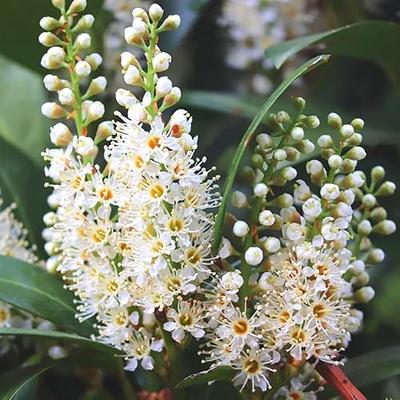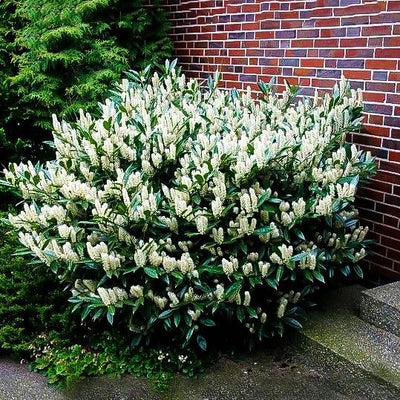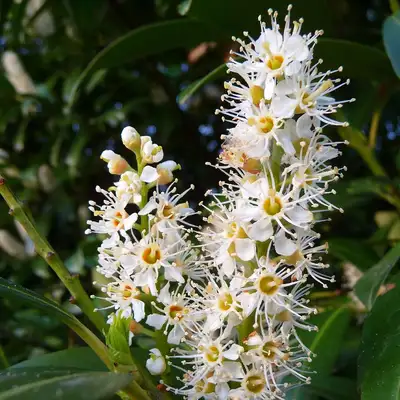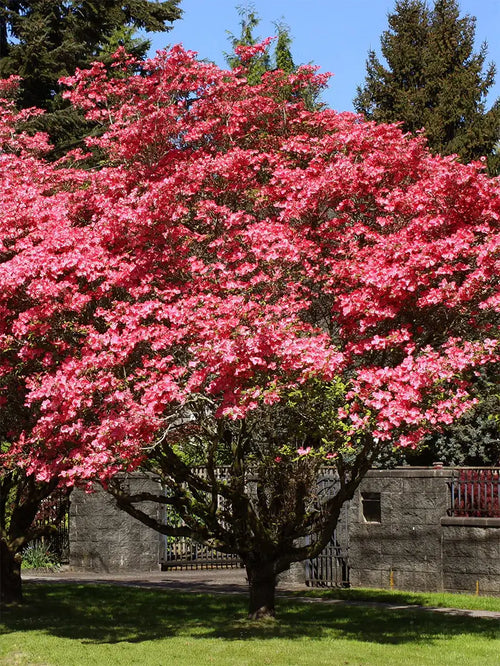A Comprehensive Guide to Growing and Caring for Prunus Laurocerasus
Cherry Laurel (Prunus laurocerasus) is a versatile evergreen shrub from the Rosaceae family. Native to Europe and Asia Minor regions, this plant is cherished for its glossy foliage, fragrant white flowers, and its adaptability to various soil and climate conditions. Whether utilized as an ornamental hedge, a privacy screen, or a standalone specimen, cultivating Cherry Laurel can greatly improve the aesthetic attraction of any garden or landscape. This exhaustive focus will delve into the intricacies of growing and caring for Cherry Laurel, exploring everything from its ideal growing conditions to maintenance practices and common issues growers encounter.

Understanding Cherry Laurel
Cherry Laurel, also known as English Laurel or Common Laurel, is a hardy evergreen shrub characterized by its dense, glossy foliage and clusters of small, fragrant white flowers that bloom in spring. It typically grows in a thick, upright habit, reaching heights up to 20 feet or more, depending on the variety. The leaves are leathery, lance-shaped, and dark green, providing year-round interest to the landscape. While the flowers are visually appealing and attract pollinators, it's important to note that the seeds and leaves of Cherry Laurel contain cyanogenic glycosides, which can be toxic if ingested.
Selecting the Right Variety Of Cherry Laurel
Before embarking on your Cherry Laurel cultivation journey, selecting the variety suitable to your specific needs and growing conditions is crucial. Several cultivars of Cherry Laurel are available individually and have unique features in size, growth habit, and foliage color. For instance, 'Otto Luyken' is a popular compact variety ideal for smaller gardens, while 'Schipkaensis' is valued for its dense, bushy growth and superior tolerance to heat and drought. Consider factors such as space availability, desired height, and aesthetic preferences when choosing the appropriate variety for your landscape.
Ideal Growing Conditions For Cherry Laurel
Cherry Laurel thrives in well-drained soil and prefers a complete to partial sun exposure location. While it can take a broad spectrum of dirt types, including clay, loam, and sandy dirt, the soil is damp but not waterlogged, as extreme water can lead to root rot. When planting Cherry Laurel, provide adequate spacing between individual plants to accommodate their mature size and encourage good air circulation, which helps prevent fungal diseases.
Planting Cherry Laurel
Planting Cherry Laurel is relatively straightforward and can be done in either spring or fall when the weather is mild. Begin by preparing the planting site, ensuring the soil is loose and weeds-free. Dig just broader and deeper than the plant's root ball. Gently remove the plant from its container and place it in the center of the hole, ensuring that the top of the root ball is level with the surrounding soil. Backfill the hole thoroughly with soil and water to settle the roots. Apply a coating of wood chippings around the bottom of the plant to keep moisture and suppress weed growth.
Watering and Fertilizing Cherry Laurel
Cherry Laurel requires regular watering during the establishment phase to promote healthy root development. Water deeply at least once a week, especially during periods of drought, ensuring that the soil remains evenly moist. Once established, Cherry Laurel is relatively drought-tolerant and typically does not require supplemental watering except during prolonged dry spells. Additionally, cherry Laurel is fertilized annually in premature spring with a congruous slow-release fertilizer to deliver vital nutrients for vigorous growth and blooming.

Pruning and Maintenance Of Cherry Laurel
Pruning is an essential aspect of Cherry Laurel maintenance, helping to maintain its desired shape, promote dense growth, and remove any dead or diseased branches. Prune Cherry Laurel uses sharp, sterilized pruning tools to make clean cuts in late winter or early spring before new growth emerges. Avoid pruning excessively during the growing season, as this can stimulate unwanted growth and detract from the plant's natural form. Regularly inspect Cherry Laurel for signs of pests or diseases, such as aphids, scale insects, or fine mildew, and bring suitable steps to prevent infestations.
Common Issues and Solutions
While Cherry Laurel is generally resilient and low-maintenance, it is exposed to specific pests and conditions that can affect its health and appearance. Common issues include aphids, which can be controlled with insecticidal soap or neem oil, and powdery mildew, which thrives in humid conditions and can be mitigated by improving air circulation and applying fungicidal treatments if necessary. Additionally, monitor Cherry Laurel for leaf discoloration, wilting, or unusual growth patterns, which may indicate underlying nutrient deficiencies or root issues.
Landscaping Applications For Cherry Laurel
Cherry Laurel is a highly adaptable and versatile plant widely used in landscaping due to its many benefits. Its dense foliage and fast growth make it an excellent hedge or screen plant, providing privacy and noise reduction while adding beauty and structure to outdoor spaces. Its evergreen leaves make it an attractive choice for foundation plantings or formal garden layouts. Cherry Laurel's ability to thrive in various soil types and climates makes it an ideal choice for landscaping projects across different regions.
Furthermore, Cherry Laurel is an excellent choice for mixed borders as it can be planted as a specimen shrub to add color, texture, and interest to any landscape. Its deep green foliage is a beautiful backdrop for other flowering plants or ornamental grasses, and its consolidated size makes it an ideal option for smaller gardens or urban landscapes. Cherry Laurel's resistance to pests and diseases makes it a low-maintenance option for homeowners and landscapers.
Cherry Laurel is a versatile and reliable plant perfect for adding beauty, structure, and functionality to outdoor spaces. Its many benefits make it a popular choice for landscaping projects of all sizes. Cherry Laurel is highly versatile and can be utilized in various landscaping applications to add beauty, structure, and functionality to outdoor spaces. It serves as an excellent hedge or screen plant, providing privacy and noise reduction while enhancing the landscape's visual appeal. Additionally, Cherry Laurel can be planted as a specimen shrub in mixed borders or used to create formal garden layouts and foundation plantings. Its evergreen foliage provides year-round interest and serves as a backdrop for other flowering plants or ornamental grasses.
In conclusion, cultivating Cherry Laurel offers numerous benefits for gardeners and landscape enthusiasts. This versatile evergreen shrub is a valuable addition to any outdoor space with its lush foliage, fragrant flowers, and adaptability to diverse growing conditions. By understanding its requirements and following proper planting and care techniques, you can appreciate the loveliness and stability of Cherry Laurel for years to come, creating a thriving and visually captivating landscape that improves the uncultivated magnificence of your surroundings.
Cherry laurel is the common name of Prunus Laurocerasus. It is an evergreen shrub native to the borders of the Black Sea.
It is used for many medicinal purposes. They produce berries that are red but later black upon ripening.

The berries ripen in August and can be consumed during the mid-autumn season. This plant grows as a shrub and can be pruned in various shapes.
The Cherry Laurel tree grows about 20-40 feet tall and is among the most pest-resistant trees than the other species of the Prunus genus. Cherry laurels can be consumed as fresh fruit or dried for later consumption. This plant can grow in partial and complete sunlight. They need moist and well-drained soil to grow and produce white flowers during spring.
The leaves of this tree are used in herbal medicines as they possess antispasmodic and sedative properties. The leaves measure about 2-6 inches long and have smooth edges. The flowers have a pleasing fragrance.
Ornamental or Hedges
The Cherry Laurel can be planted as an ornamental plant in your garden. The shrubs can also be used as hedges to create partitions. It is considered that the seeds of this plant are poisonous; therefore, consuming seeds is not advisable.
The most popular forms of Cherry Laurel and Okame Cherry are the “Otto Luyken” and “Schip Laurel.” These are amongst the most popular shrubs in American home gardens. The tree is perfect for attracting birds to your garden, as the birds love the fruit. It is advisable to prune cherry laurels whenever required, as they may become very dense if they are not pruned.
Growing Cherry Laurel in your garden can be a great experience because of its scented flowers, evergreen leaves, sweet berries, and the chirping birds it attracts.



















































